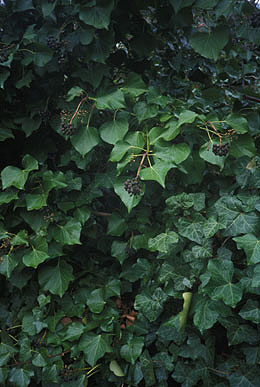
|
| Ivy; Hedera Helix L. |
Ginseng Family; ARALIACEÆ
|
| An evergreen vine that covers everything within reach, this common and well-known Old World plant is the worst weed in
Seattle. No other weed causes so much damage: it strangles trees, smothers delicate native wildflowers, blocks sunlight, sucks up tons of
precious soil moisture, harbors rats, damages house exteriors, and sometimes even grows
through house walls. |
| Although ivy is usually flowerless while only a sprawling groundcover, once it gets onto a fence or up a tree, it makes dinky,
yellow-green flowers in late summer or fall, which are highly attractive to bees, wasps, hornets, flies, Red Admirals and Painted Ladies. In
late winter the berries ripen dull black and are eagerly sought by Band-tailed Pigeons and other birds. Seedlings are abundant. |
| It has no natural checks to its rapacity. Growing to the top of any tree, with age its woody vines attain up to 5 inches or more in
diameter and can deform tree trunks. Many local ravines which originally supported a rich mosaic of varied wildflowers, ferns, Oregon Grape
and Salal, are now monotonously covered with a sombre and barren blanket of dusky ivy: ivy ghettos. There isn't a single native plant that
so monopolizes and spreads as does ivy (Salal comes closest). It tolerates the deepest shade and grows even in heavy, wet clay. |
| Yet we plant it because we love its virtues more than we hate its vices. It's versatile, cheerfully evergreen, comes in various
cutleaf and variegated forms, is cheap and grows fast. No serious bugs or diseases really bother it, probably finding it too stinking and
poisonous to be an attractive victim. Fishermen have tried using its odor as bait, but since they tend to try virtually everything this is no particular
credit to ivy. Herbal practitioners too have sought in ivy something valuable. |
In brief, ivy should be treated as an
outlaw and grown only under strict supervision. For groundcovers, fence-screening,
wall-climbing or most other landscaping purposes where it might be considered desirable, there are less rampant and equally or more beautiful substitutes.
|
Originally published as the Seattle Tilth newsletter Weed of the Month in January 1989, along with an illustration drawn by Annie Figliola.
Back |
|
|

